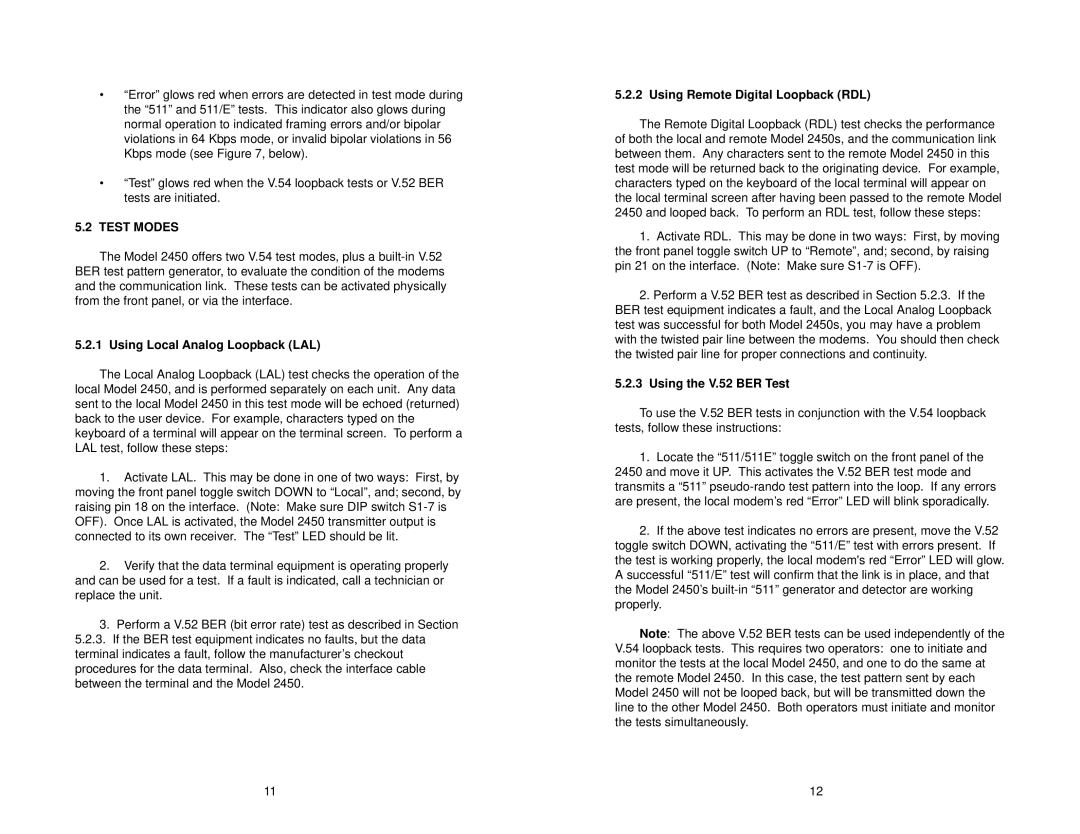•“Error” glows red when errors are detected in test mode during the “511” and 511/E” tests. This indicator also glows during normal operation to indicated framing errors and/or bipolar violations in 64 Kbps mode, or invalid bipolar violations in 56 Kbps mode (see Figure 7, below).
•“Test” glows red when the V.54 loopback tests or V.52 BER tests are initiated.
5.2TEST MODES
The Model 2450 offers two V.54 test modes, plus a
BER test pattern generator, to evaluate the condition of the modems and the communication link. These tests can be activated physically from the front panel, or via the interface.
5.2.1 Using Local Analog Loopback (LAL)
The Local Analog Loopback (LAL) test checks the operation of the local Model 2450, and is performed separately on each unit. Any data sent to the local Model 2450 in this test mode will be echoed (returned) back to the user device. For example, characters typed on the keyboard of a terminal will appear on the terminal screen. To perform a LAL test, follow these steps:
1.Activate LAL. This may be done in one of two ways: First, by moving the front panel toggle switch DOWN to “Local”, and; second, by raising pin 18 on the interface. (Note: Make sure DIP switch
2.Verify that the data terminal equipment is operating properly and can be used for a test. If a fault is indicated, call a technician or replace the unit.
3.Perform a V.52 BER (bit error rate) test as described in Section
5.2.3.If the BER test equipment indicates no faults, but the data terminal indicates a fault, follow the manufacturer’s checkout procedures for the data terminal. Also, check the interface cable between the terminal and the Model 2450.
5.2.2 Using Remote Digital Loopback (RDL)
The Remote Digital Loopback (RDL) test checks the performance of both the local and remote Model 2450s, and the communication link between them. Any characters sent to the remote Model 2450 in this test mode will be returned back to the originating device. For example, characters typed on the keyboard of the local terminal will appear on the local terminal screen after having been passed to the remote Model
2450 and looped back. To perform an RDL test, follow these steps:
1.Activate RDL. This may be done in two ways: First, by moving the front panel toggle switch UP to “Remote”, and; second, by raising pin 21 on the interface. (Note: Make sure
2.Perform a V.52 BER test as described in Section 5.2.3. If the BER test equipment indicates a fault, and the Local Analog Loopback test was successful for both Model 2450s, you may have a problem with the twisted pair line between the modems. You should then check the twisted pair line for proper connections and continuity.
5.2.3Using the V.52 BER Test
To use the V.52 BER tests in conjunction with the V.54 loopback tests, follow these instructions:
1.Locate the “511/511E” toggle switch on the front panel of the 2450 and move it UP. This activates the V.52 BER test mode and transmits a “511”
2.If the above test indicates no errors are present, move the V.52 toggle switch DOWN, activating the “511/E” test with errors present. If the test is working properly, the local modem's red “Error” LED will glow. A successful “511/E” test will confirm that the link is in place, and that the Model 2450’s
Note: The above V.52 BER tests can be used independently of the V.54 loopback tests. This requires two operators: one to initiate and monitor the tests at the local Model 2450, and one to do the same at the remote Model 2450. In this case, the test pattern sent by each Model 2450 will not be looped back, but will be transmitted down the line to the other Model 2450. Both operators must initiate and monitor the tests simultaneously.
11 | 12 |
